|
Report
from
Europe
EU trade in wood furniture rises in 2014
The sharp rise in the EU trade surplus in wooden furniture
between 2010 and 2013 came to a halt last year as the pace
of increase in EU exports slowed while there was an
upturn in imports (Chart 1).
EU28 wooden furniture exports were valued at €8.43
billion in 2014, 2.3% more than in 2013. EU28 imports of
wooden furniture were valued at €5.11 billion in 2014,
10.4% greater than the previous year.
The EU 28‟s trade surplus in wooden furniture fell 8.2%
from €3.62 billion in 2013 to €3.32 billion in 2014.
Nevertheless, the trade surplus remains very high
compared to the boom years prior to the financial crises
when European manufacturers were focusing most of their
attention on domestic sales and external suppliers, notably
in China, were making significant inroads into the market.
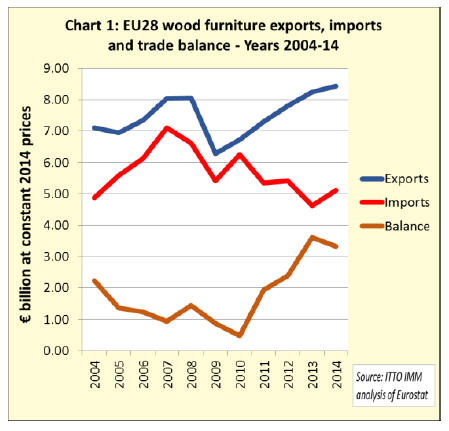
Putting these figures into perspective it will be seen that
EU external trade in wooden furniture is relatively small
compared to total consumption, which is about €50 billion
per year most of which is from domestic manufacturers.
Only about one quarter of wooden furniture consumed in
the EU member states ever crosses a national boundary.
Total internal trade in wooden furniture between EU
countries has averaged around €15 billion per year since
2009.
Exports of growing importance for EU furniture
manufacturers
While external trade forms only a small part of the EU
furniture sector, it is becoming much more relevant to
European furniture manufacturers.
During the current recession, manufacturers have become
more focused on improving competitiveness relative to
manufacturers in other countries, particularly China. With
consumption static in domestic markets, European
furniture companies are seeking to increase sales in other
parts of the world.
This outward looking strategy has led to a consistent rise
in EU wooden furniture exports over the last five years
(Chart 2). In 2014, EU28 export values increased to North
America (+15% to €1.48 billion), China (+17% to €570
million), the Middle East (+3% to €900 million), and
Africa (+11% to €520 million).
These gains during 2014 offset a 9% decline in exports to
the CIS region to €1.46 billion. Falling exports to the CIS
are due mainly to slowing sales in Russia following
economic sanctions in response to the Ukraine conflict and
declining international prices for Russian oil and gas
which has weakened the economy and affected consumer
spending.
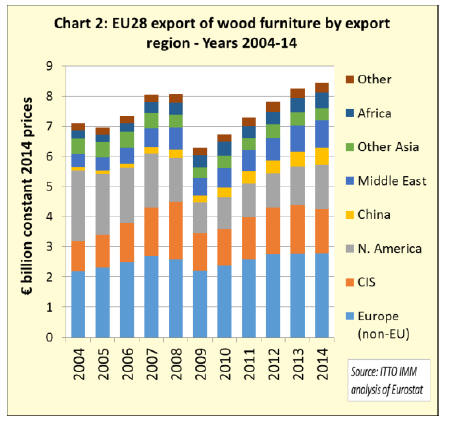
The rise in EU exports of wooden furniture is being led by
manufacturers in Italy, Poland and Germany (Chart 3).
Preliminary data for 2014 indicates that exports of wooden
furniture (including intra-EU trade) increased from Italy
(+4% to €5.25 billion), Poland (+12% to €4.14 billion) and
Germany (+2% to €4.12 billion).
Last year, Poland overtook Germany to become Europe‟s
second largest exporter of wooden furniture. Wooden
furniture exports have also been rising rapidly from
Lithuania, Romania, Spain and Portugal in the last five
years. However exports from Sweden and France have
declined while exports from Denmark have been stable
(Chart 3).
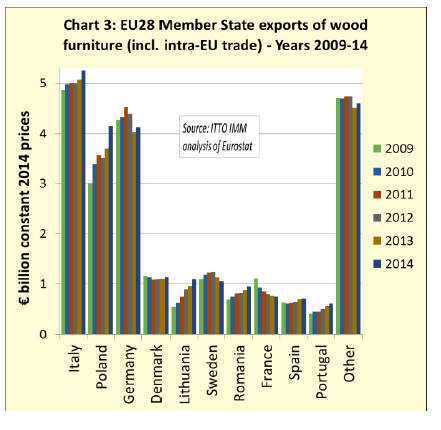
EU wooden furniture imports rebounded in 2014
After falling 14% in 2013, the value of EU wooden
furniture imports rebounded by 10% in 2014 to reach
€5.12 billion (Chart 4). Imports from China fell 16% in
2013 but recovered by 14% to €2.81 billion in 2014.
EU imports from the rest of the world also rebounded in
2014, increasing 8% to €2.3 billion after a 13% decline in
2013.
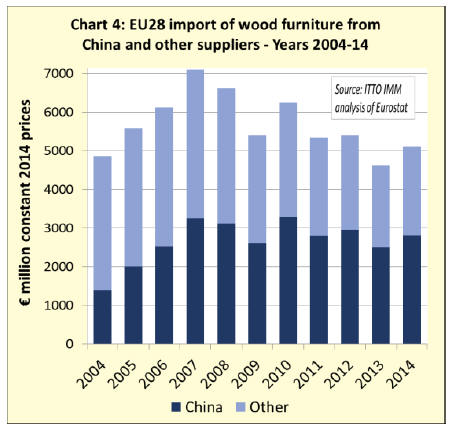
EU imports of wooden furniture from Vietnam increased
strongly last year, rising 19% to €596 million. This
followed a 9% decline in 2013. After several years of
declining sales, Indonesian wooden furniture recovered a
little ground in the EU market in 2014, with imports rising
7% to €296 million.
There was also a 13% rise in imports from India to €132
million. Imports from Malaysia and Brazil remained stable
between 2013 and 2014 at €172 million and €106 million
respectively (Chart 5).
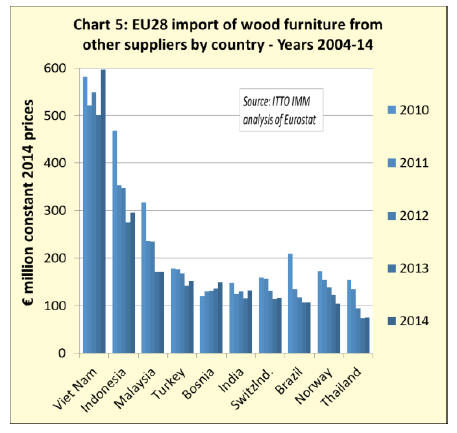
Analysis of economic indicators in Europe does not
provide an obvious explanation for the sharp fall in EU
wooden furniture imports in 2013 and rebound in 2014.
Throughout this period there was slow growth and flat
consumer spending in the EU. Also exchange rates did not
change significantly.
However demand in the UK, which is the largest European
importer of wooden furniture accounting for nearly one
third of all imports from outside the EU, was recovering
more strongly in 2014. There was also a particularly sharp
increase in wooden furniture import penetration into
Germany, France, Italy and Sweden last year.
﹛
The EU wooden furniture import trend in the last two
years may have been affected by supply side issues. Some
new wooden furniture manufacturing capacity has come
on-stream in Eastern Europe 每 notably in Poland,
Lithuania and Romania每 and this may have depressed EU
imports from other regions in 2013.
In 2014, slowing in China‟s domestic market may have reenergised
efforts by Chinese and other Asian
manufacturers to increase sales in Europe.
Another factor is introduction of the EUTR in March 2013
which may have briefly disrupted EU imports of wooden
furniture as retailers struggled to obtain necessary
assurances of legal wood origin from their overseas
suppliers. If so, the rebound in 2014 may be a sign that
overseas suppliers have been able to satisfy these new
regulatory demands.
CSIL reports rise in global furniture trade to US$128
billion
The latest edition of World Furniture
(www.worldfurnitureonline.com), the quarterly journal of
the Italy-based furniture industry research association
CSIL, includes a wide ranging review of recent
developments in the international furniture sector.
The CSIL analysis of world furniture trade, which draws
on data from the world‟s 70 largest economies, indicates
that total trade value was US$128 billion in 2013, around
1% of all global trade in manufactured products. The
leading furniture importers during the year were the
United States, Germany, France, the UK and Canada.
The annual trend in global furniture trade reported by
CSIL is shown in Chart 6. In the period 2004 to 2008,
global trade was rising driven primarily by imports into
the United States, with smaller increases into the United
Kingdom, France, Germany and Canada.
Trade declined during the financial crises in 2009, but
there was uninterrupted growth in the 2010 to 2013 period.
This was driven mainly by recovery in North America and
growth in emerging markets. The European market
remained relatively weak during this period, although
there was some growth in imports into Germany and the
UK.
CSIL estimates that growth in global trade continued into
2014 and projected a further increase to close to US$140
billion in 2015. Import penetration for furniture (measured
as the ratio between imports and consumption) is presently
about 30% on a world scale.
According to CSIL, the main furniture exporting countries
in 2013 were China, Italy, Germany, Poland and the
United States. The relative positions of the main exporting
countries changed considerably between 2004 and 2013.
China has become the world's leading exporter, overtaking
Italy which is currently in second position. Between 2004
and 2013 China increased share of global furniture trade
from 14% to 38%.
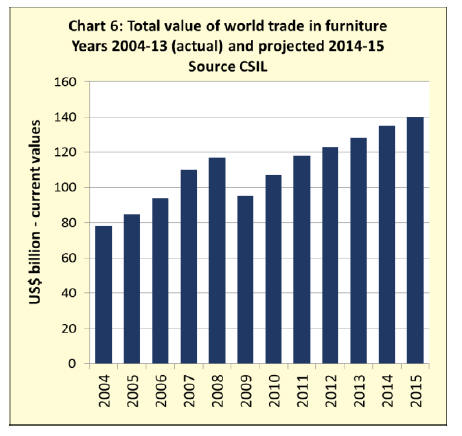
Another major change is the rapid emergence of Vietnam,
which jumped from 15th to 6th position in the period 2004
to 2013.
CSIL highlight that a significant proportion of furniture
trade is more accurately described as ※intra-regional§
rather than truly ※international§. This is particularly true
of Europe.
In the EU plus Norway, Switzerland and Iceland, 76% of
trade takes place between countries within the region and
only 24% is with countries in other parts of the world. In
the NAFTA area (USA, Canada and Mexico), about 27%
of foreign furniture trade is within the three countries and
73% is with countries outside the region.
In the Asia and Pacific region, about 39% of furniture
trade is within the region.
Western European furniture market recovers slowly
The latest edition of World Furniture also provides CSIL‟s
update on recent trends in furniture consumption and
production in Western Europe. CSIL note that the region‟s
furniture sector has faced significant difficulties in recent
years but is now slowly recovering.
CSIL estimate that total Western European furniture
market value was €71 billion at producer prices in 2013, a
slight downturn compared to the previous year and below
pre-crises levels.
However the market remains globally significant,
accounting for one quarter of the value of world furniture
consumption, 40% of world furniture import value and
30% of world furniture export value. CSIL estimate that
the market grew by 0.5% in 2014 and project 1% growth
in 2015.
CSIL identify the dominant markets in Western Europe as
Germany, France, the UK and Italy. These four countries
account for two thirds of total furniture demand in the
region.
Market performances have varied widely between
countries. While several markets including Spain, Italy
and France, are still well below pre-recession levels,
others are performing well including Norway, Switzerland
and Sweden.
European specifiers need to be more flexible in their
choice of hardwood
Use of verified sustainable timber could be limited by
specifiers being too restrictive in choice of species and
certification scheme. This was the conclusion of a seminar
on sustainable timber in government projects organised by
the Netherlands Green Deal initiative reported in the
ETTF newsletter.
An alliance of industry, end users, retailers, NGOs and
government including Tropenbos and the Royal
Netherlands Timber Trade Association (NTTA) aims to
make certified sustainable timber the Netherlands market
norm. The seminar, under the title ※Stimulating
Sustainable Forestry§, took place in Tiel at the
Rivierenland Water Board (Waterschap).
Delegates heard that certified sustainable timber has risen
from 58% to 86% of NTTA members‟ total imports since
2008. However, in hardwood certified material‟s share is
only 55%, so ※considerable§ efforts were needed to boost
sales, particularly in Netherland‟s key marine products
sector, said speakers. One route to market growth, it was
suggested, was to give contractors greater specification
freedom.
The Netherlands government‟s Timber Procurement
Assessment Committee (TPAC) accepts FSC, PEFC and
Malaysian MTCS certification as proof of sustainability.
According to Annemieke Visser Winterink of the Probos
forestry foundation, specifiers should therefore opt for
material verified under any of these schemes, and focus on
technical capabilities rather than specific species.
※By adhering to government certification criteria and
specifying physical mechanical properties rather than
species, you give contractors freedom of choice,§ she said.
※That not only potentially increases the quality and cost
effctiveness of the project, but helps broaden use of wood
from sustainably managed forests."
International Hardwood Conference
The ETTF will jointly host the 2015 International
Hardwood Conference in Copenhagen on September 17
2015 with the European Sawmillers Organisation (EOS).
Consequently it will broaden to encompass non-European
species, including tropical, as well as European
hardwoods.
European hardwood trade struggles with low
profitability and investment
The Annual Review published at the turn of the year by
the Germany based EUWID journal provides a wealth of
information on European and North American corporate
investment, divestment and bankruptcies in the forest
products sector during the previous 12 months. As such
it‟s a rare and valuable insight into the underlying
financials and direction of development of the sector as a
whole.
The hardwood sector, being generally dominated by
smaller fragmented firms, does not feature strongly
compared to the much larger more consolidated softwood
and panels industries.
However there are some interesting observations, most
reinforcing the image of an industry struggling with low
levels of investment and innovation and rising levels of
competition.
For example: In the European import trade, the main news
in 2014 identified by EUWID was the break-up of Danish
Group Dalhoff Larsen and Horneman A/S (DLH) which
formerly had several large stock holding operations in
Western Europe and was also a leading distributor of
tropical wood into Eastern Europe.
EUWID note that ※furthermore, other importers of tropical
wood have also experienced economic difficulties. A
prominent example in this context is the Swiss group
Precious Woods Holding AG which in the third quarter of
the year announced that continuation of its business was in
jeopardy.
In February German company B&T Wood Trading
GmbH, Meerbeck, was compelled to submit an application
for insolvency. Dutch company Zuid-Nederlandse
Houtindustrie B.V. terminated its business activities in
Octoner§.
The rate of reduction in European sawmill capacity (both
softwood and hardwood) during 2014 was much lower
than in 2013. EUWID notes that ※the consolidation in the
European sawmill sector which in the estimation of market
participants continues to be necessary has not taken place
this year§.
The implication is that the domestic wood sector continues
to suffer from a degree of over-capacity, always a problem
for external suppliers selling into the market.
On the other hand, nor is there any news of any large new
investments in the European hardwood sawmilling sector
during 2014.
Similarly, there were very few new developments in
European wood-based panel and surfaces sector in 2014
after a large number of transactions in 2013.
The European Luxury Vinyl Tiles (LVT) continues to
expand and, according to EUWID, this is likely at the
expense of other material suppliers to the flooring sector.
The main trend identified in the wood flooring sector is a
continuing shift in production from Western to Eastern
Europe, with reference made to new or expanding
facilities in Lithuania, Romania and the Czech Republic.
WPC taking greater share of European markets important
for tropical wood.
WPC is having a particularly significant impact in markets
for exterior products in Germany, France, UK, Belgium,
Netherlands and Spain. WPC products sold in Europe are
mainly imported from the USA and China.
This data needs to be considered alongside the decline in
EU imports of tropical hardwood decking profiles from
around 747,000 cu.m in 2007 to less than 300,000 cu.m in
2013.
It‟s clear that the expansion in EU consumption of WPC
combined with the installation of around 300,000 cu.m of
capacity for thermal treatment of temperate wood in
Europe, not to mention expansion of capacity for
acetylation and other forms of chemical treatment,
presents a significant challenge to tropical wood in
European markets for exterior products.
AHEC highlight continuing focus on oak and walnut in
European furniture
A recent report from the American Hardwood Export
Council (AHEC) reviews hardwood furniture trends based
on a visit to the annual IMM furniture show in Germany.
From observations and interviews at the show AHEC
suggests that, after more than five years of poor sales and
falling consumption, the market for high-end furniture in
Europe is improving.
As in previous years, designs in oak and walnut were
dominant. Nearly all walnut was from the United States,
while most oak was European. AHEC suggest this is
primarily due to the easy access to European oak by
Central European manufacturers.
These manufacturers are also now able to utilise relatively
low grades and short specifications which can be sourced
very competitively. Increasing use of these grades has
gone hand-in-hand with deliberate marketing of the
※rustic§ look in oak furniture. AHEC also suggest that
solid wood is in vogue and there appears to be less veneer
used than in the past.
AHEC note that the only tropical wood on display was in
the international section and mainly in the Indonesian
pavilion. Temperate species other than oak and walnut
were also not much in evidence. There was some beech,
mostly for chairs and table legs but not for large visual
surfaces of table tops and cabinet doors.
AHEC observed that there was lack of strong
environmental messages and branding at the show,
surprising given that IMM Cologne is the main shop
window for high end commercial furniture sold in Europe.
Most furniture manufacturers apparently have yet to
embrace LCA or EPDs for active market development 每
although some companies are now considering this as a
way to differentiate product in a highly competitive
market.
* The market information above has been generously provided
by the Chinese Forest Products Index Mechanism (FPI)
|